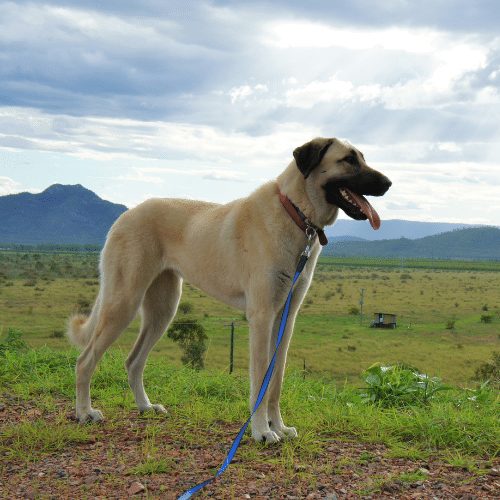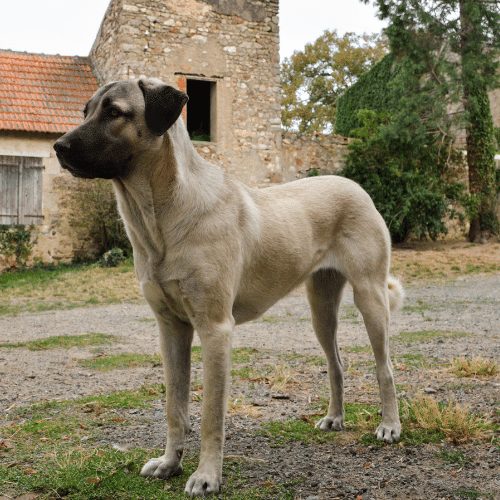Anatolian Shepherd Growth Chart & Puppy Weight Calculator
May 8, 2021 2022-08-16 17:18Do you own an Anatolian Shepherd puppy and wonder what his adult size will be? Our puppy growth chart and weight calculator is the most accurate one on the internet! Simply put in your pup’s weight and age and check out our predictions.
Anatolian Shepherd Weight Calculator & Growth Chart
Table of Contents

What does a full-grown Anatolian Shepherd weigh?
The American Kennel Club calls for the following sizes in Anatolian Shepherds:
- Females are around 27 inches tall and weigh 80-120 pounds
- Males are about 29 inches tall and weigh 110-150 pounds
How tall exactly your Anatolian will get largely depends on genetics.
Size is not passed on in a straight-forward way like for example colors in dogs. Being especially tall or small is a characteristic that can skip one or several generations. That means that your puppy’s grandparents might have been very tall and heavy Anatolians, his parents could have been of average size, and your puppy himself again is an especially tall dog.
Not all puppies of one litter grow up to be the same size either – there can be a lot of genetic variation among full siblings and littermates.
How much do Anatolian Shepherd puppies weigh?
At birth, most Anatolian Shepherd puppies weigh around 1-2 pounds. It is important to note that birth weight is not an accurate predictor of adult size. The biggest puppy of the litter at birth does not necessarily turn out to be the largest adult dog.
The exact birth weight of a puppy is mostly determined by the intrauterine placement (meaning where in the uterus they were lying, and how well their placenta provided them with nutrients).
A dog’s adult size however is determined by genetics. Many smaller pups of a litter quickly catch up in weight and even overtake their larger littermates.
By the time Anatolian Shepherd puppies go to their forever homes at 2 months of age, they will already weigh about 12 pounds, and they keep gaining weight quickly!

How much does a 3 month old Anatolian Shepherd weigh?
At 3 months, just 4 weeks after bringing your puppy home, he has already gained a bunch of weight and should be around 35-45 pounds. During the first 6 months of their lives dogs grow the fastest – and this is especially obvious in large and giant breeds such as the Anatolian. It is crucial that you feed your dog a well-balanced and high-quality diet to take care of his nutritious needs during the period of rapid growth.
How much does a 6 month old Anatolian weigh?
At half a year of age, an Anatolian should be between 65 and 90 pounds. At this age, the differences between the smaller and larger dogs of the breed start to become quite big – a small female may only weigh 2/3rds of a large male. While weight alone is not a sign of health, if your dog is considerably smaller and lighter, you should consult a vet to make sure he is growing well.
At what age is an Anatolian Shepherd full-grown?
As a large or giant dog breed, Anatolian Shepherds continue growing for long after their first birthday. Across all breeds of dogs it is true that the larger a dog is, the longer it takes him to reach his adult size. While some toy breeds are finished growing as young as 10 months of age, giant breeds can grow up to their 2nd birthday.
Your Anatolian Shepherd will probably reach his final size around 18-20 months of age. However even after that time he can continue to gain weight and build up muscle mass. A large dog is only a “canine teenager” at 18 months old, and will continue filling out and becoming more muscular until his third birthday.
If your dog is too light for his age
If your dog is lighter than the above guidelines, don’t worry. Here are the most common reasons behind this:
Intestinal parasites
Intestinal parasites such as giardia or roundworms are common among all dogs, especially puppies. They are easily treatable with prescription medicine from a veterinarian. Intestinal parasites become apparent when a dog has frequent diarrhea or is very thin even though you are feeding large quantities of food. You could also notice that his coat is not shiny and feels rough.
Intestinal parasites stunt a puppy’s growth by consuming the nutrition inside his colon, in addition to causing diarrhea and malabsorption. It is crucial to visit a vet as soon as you suspect that your dog might be suffering from these. The good news is that as soon as you have the right medicine on board, it takes care of these issues quickly. As soon as your dog is free of the parasites, he will catch up on weight and grow normally.
Mixed breeds
The Anatolian Shepherd is a rare breed in the US. Unfortunately, some dishonest breeders sell puppies as “pure-bred” Anatolians that actually are a mix of an Anatolian Shepherd and one or more other breed(s). These breeds are frequently smaller than the Anatolian himself. As a result, the puppies also will not grow to be as tall as their pure-bred cousins.
A genetic test is the best way to make sure that your dog is indeed a full-blooded Anatolian. If he is mixed with a different breed, don’t worry: It is normal that he will grow up to be a bit smaller and lighter. Of course, he will be just as amazing of a companion as a pure-bred Anatolian Shepherd!


